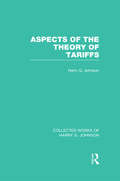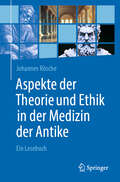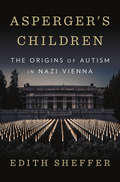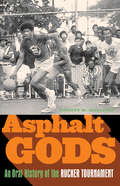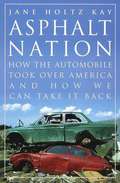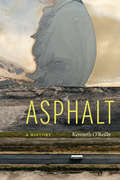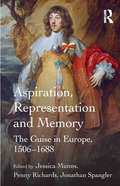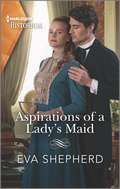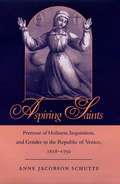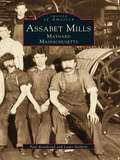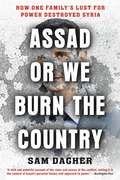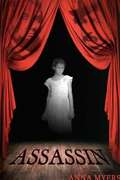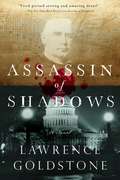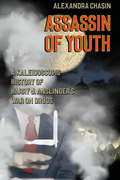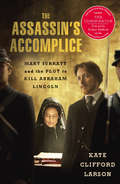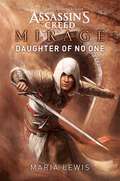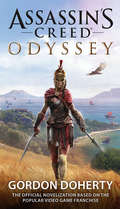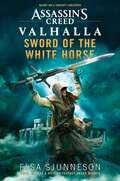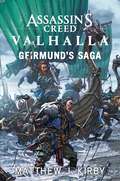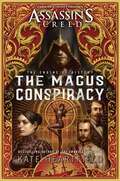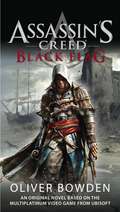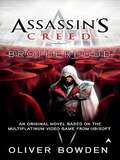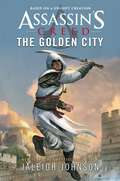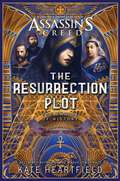- Table View
- List View
Aspects of the Theory of Tariffs (Collected Works of Harry G. Johnson)
by Harry JohnsonAn internationally acknowledged authority on all aspects of the theory of international trade and payments, this book collects Harry Johnson’s contributions to the study of international trade, including a critique of the theory of effective protection. The book discusses: the integration of income distribution and other aspects of the economy into the positive theory of tariffs the issues raised by the use of tariffs to promote economic development the implications of distortions of various kinds in the working of competition for tariff theory and policy the costs of protection the implications of effective protection for world economic development and the economic effects of trade preferences the question of free trade and the extent to which it requires the harmonization other aspects of economic policy.
Aspekte der Theorie und Ethik in der Medizin der Antike: Ein Lesebuch
by Johannes RöscheWie wurde in der Antike medizinisch gedacht? Was ist der Nutzen für das Leben und insbesondere für im Gesundheitssystem tätige Menschen? In diesem Buch werden die Verbindungen zwischen medizinischem Denken und Philosophie in der Antike dargestellt. Mit Empedokles und Galen werden bedeutende Persönlichkeiten vorgeführt und davon ausgehend die umfangreiche Tradition medizinischen Denkens in der Antike aufgezeigt. Ebenso werden naturphilosophische Konzepte und Ethik des Corpus hippocraticum beleuchtet. Nicht zuletzt wird im Bereich der Ethik darauf verwiesen, wie ethische Konzepte in allgemeineren philosophischen oder sozialen Systemen verankert sind.
Asperger's Children: The Origins Of Autism In Nazi Vienna
by Edith ShefferA groundbreaking exploration of the chilling history behind an increasingly common diagnosis. Hans Asperger, the pioneer of autism and Asperger syndrome in Nazi Vienna, has been celebrated for his compassionate defense of children with disabilities. But in this groundbreaking book, prize-winning historian Edith Sheffer exposes that Asperger was not only involved in the racial policies of Hitler’s Third Reich, he was complicit in the murder of children. As the Nazi regime slaughtered millions across Europe during World War Two, it sorted people according to race, religion, behavior, and physical condition for either treatment or elimination. Nazi psychiatrists targeted children with different kinds of minds—especially those thought to lack social skills—claiming the Reich had no place for them. Asperger and his colleagues endeavored to mold certain "autistic" children into productive citizens, while transferring others they deemed untreatable to Spiegelgrund, one of the Reich’s deadliest child-killing centers. In the first comprehensive history of the links between autism and Nazism, Sheffer uncovers how a diagnosis common today emerged from the atrocities of the Third Reich. With vivid storytelling and wide-ranging research, Asperger’s Children will move readers to rethink how societies assess, label, and treat those diagnosed with disabilities.
Asphalt Gods: An Oral History of the Rucker Tournament
by Vincent M. MallozziThe real basketball deal–the inside story of Harlem’s legendary tournament and the pros and playground legends who have made it world famous.Earl “The Goat” Manigault. Herman “Helicopter” Knowings. Joe “The Destroyer” Hammond. Richard “Pee Wee” Kirkland. These and dozens of other colorfully nicknamed men are the “Asphalt Gods,” whose astounding exploits in the Rucker Tournament, often against multimillionaire NBA superstars, have made them playground divinity. First established in the 1950s by Holcombe Rucker, a New York City Parks Department employee, the tournament has grown to become a Harlem institution, an annual summer event of major proportions. On that fabled patch of concrete, unknown players have been lighting it up for decades as they express basketball as a freestyle art among their peers and against such pro immortals as Julius Erving and Wilt Chamberlain. X’s and O’s are exchanged for oohs and aahs in one of the great examples of street theater to be found in urban America.Asphalt Gods is a streetwise, supremely entertaining oral history of a tournament that has influenced everything from NBA playing style to hip-hop culture. Now, legends transmitted by word of mouth find a home and the achievements of basketball’s greatest unknowns a permanent place in the game’s record.
Asphalt Nation: How the Automobile Took Over America and How We Can Take It Back
by Jane Holtz KayAsphalt Nation is a major work of urban studies that examines how the automobile has ravaged America's cities and landscape, and how we can fight back. The automobile was once seen as a boon to American life, eradicating the pollution caused by horses and granting citizens new levels of personal freedom and mobility. But it was not long before the servant became the master-- public spaces were designed to accommodate the automobile at the expense of the pedestrian, mass transportation was neglected, and the poor, unable to afford cars, saw their access to jobs and amenities worsen. Now even drivers themselves suffer, as cars choke the highways and pollution and congestion have replaced the fresh air of the open road. Today our world revolves around the car-- as a nation, we spend eight billion hours a year stuck in traffic. In Asphalt Nation, Jane Holtz Kay effectively calls for a revolution to reverse our automobile-dependency. Citing successful efforts in places from Portland, Maine, to Portland, Oregon, Kay shows us that radical change is not impossible by any means. She demonstrates that there are economic, political, architectural, and personal solutions that can steer us out of the mess. Asphalt Nation is essential reading for everyone interested in the history of our relationship with the car, and in the prospect of returning to a world of human mobility.
Asphalt: A History
by Kenneth O'ReillyLa Brea Tar Pits once trapped prehistoric mammals. Today that killer has a chemical cousin in the Athabasca oil sands of Alberta, Canada—immense deposits of natural asphalt destined for upgrading to synthetic crude oil. If the harvesting of this natural asphalt continues unabated, we might find ourselves stuck in a muck of a different kind. Humanity has used asphalt for thousands of years. This humble hydrocarbon may have glued the first arrowhead to the first shaft, but the changes wrought by this material are most dramatic since its emergence as pavement. Since the 1920s the automobile and blacktop have allowed unprecedented numbers of Americans to experience the beauty of their continent from the Adirondacks to the Rockies and beyond, to Big Sur and the Pacific Coast Highway. Blacktop roads, runways, and parking lots constitute the central arteries of our environment, creating a distinct &“political territory&” and a &“political economy of velocity.&” In Asphalt: A History Kenneth O&’Reilly provides a history of this everyday substance. By tracing the history of asphalt—in both its natural and processed forms—from ancient times to the present, O&’Reilly sets out to identify its importance within various contexts of human society and culture. Although O&’Reilly argues that asphalt creates our environment, he believes it also eventually threatens it. Looking at its role in economics, politics, and global warming, O&’Reilly explores asphalt&’s contribution to the history, and future, of America and the world.
Aspiration, Representation and Memory: The Guise in Europe, 1506–1688
by Penny Richards Jessica MunnsExploiting the turbulence and strife of sixteenth-century France, the House of Guise arose from a provincial power base to establish themselves as dominant political players in France and indeed Europe, marrying within royal and princely circles and occupying the most important ecclesiastical and military positions. Propelled by ambitions derived from their position as cadets of a minor sovereign house, they represent a cadre of early modern elites who are difficult to categorise neatly: neither fully sovereign princes nor fully subject nobility. They might have spent most of their time in one state, France, but their interests were always ’trans-national’; contested spaces far from the major centres of monarchical power - from the Ardennes to the Italian peninsula - were frequent theatres of activity for semi-sovereign border families such as the Lorraine-Guise. This nexus of activity, and the interplay between princely status and representation, is the subject of this book. The essays in this collection approach Guise aims, ambitions and self-fashioning using this ’trans-national’ dimension as context: their desire for increased royal (rather than merely princely) power and prestige, and the use of representation (visual and literary) in order to achieve it. Guise claims to thrones and territories from Jerusalem to Naples are explored, alongside the Guise ’dream of Italy’, with in-depth studies of Henry of Lorraine, fifth Duke of Guise, and his attempts in the mid-seventeenth century to gain a throne in Naples. The combination of the violence and drama of their lives at the centres of European power and their adroit use of publicity ensured that versions of their strongly delineated images were appropriated by chroniclers, playwrights and artists, in which they sometimes featured as they would have wished, as heroes and heroines, frequently as villains, and ultimately as characters in the narratives of national heritage.
Aspirations of a Lady's Maid (Breaking the Marriage Rules)
by Eva ShepherdSeparated by classBrought together by passionHaving finally fulfilled her dream of opening a hairdressing parlor, Nellie Regan has no interest in love ruining her plans. After Nellie is caught mocking landowner Dominic Lockhart’s lifeless engagement to Lady Cecily, she’s not expecting him to defend her in a tavern brawl. Now the frustratingly handsome gentleman must recuperate in her home! Close quarters stir simmering attraction…but Nellie’s determined to follow her head, not her heart. Is Dominic willing to do the same?"A very good history, witty and romantic. If this is her first book, I'm waiting for the next one."—Goodreads on Beguiling the Duke
Aspiring Saints: Pretense of Holiness, Inquisition, and Gender in the Republic of Venice, 1618-1750
by Anne Jacobson SchutteWinner of an Honorable Mention in the Professional/Scholarly Publishing Awards given by the Association of American PublishersBetween 1618 and 1750, sixteen people—nine women and seven men—were brought to the attention of the ecclesiastical authorities in Venice because they were reporting visions, revelations, and special privileges from heaven. All were investigated, and most were put on trial by the Holy Office of the Inquisition on a charge of heresy under various rubrics that might be translated as "pretense of holiness."Anne Jacobson Schutte looks closely at the institutional, cultural, and religious contexts that gave rise to the phenomenon of visionaries in Venice. To explain the worldview of the prosecutors as well as the prosecuted, Schutte examines inquisitorial trial dossiers, theological manuals, spiritual treatises, and medical works that shaped early modern Italians' understanding of the differences between orthodox Catholic belief and heresy. In particular, she demonstrates that socially constructed assumptions about males and females affected how the Inquisition treated the accused parties. The women charged with heresy were non-elites who generally claimed to experience ecstatic visions and receive messages; the men were usually clergy who responded to these women without claiming any supernatural experience themselves. Because they "should have known better," the men were judged more harshly by authorities.Placing the events in a context larger than just the inquisitorial process, Aspiring Saints sheds new light on the history of religion, the dynamics of gender relations, and the ambiguous boundary between sincerity and pretense in early modern Italy.
Aspiring Saints: Pretense of Holiness, Inquisition, and Gender in the Republic of Venice, 1618-1750 (The\other Voice In Early Modern Europe Ser.)
by Anne Jacobson SchutteWinner of an Honorable Mention in the Professional/Scholarly Publishing Awards given by the Association of American PublishersBetween 1618 and 1750, sixteen people—nine women and seven men—were brought to the attention of the ecclesiastical authorities in Venice because they were reporting visions, revelations, and special privileges from heaven. All were investigated, and most were put on trial by the Holy Office of the Inquisition on a charge of heresy under various rubrics that might be translated as "pretense of holiness."Anne Jacobson Schutte looks closely at the institutional, cultural, and religious contexts that gave rise to the phenomenon of visionaries in Venice. To explain the worldview of the prosecutors as well as the prosecuted, Schutte examines inquisitorial trial dossiers, theological manuals, spiritual treatises, and medical works that shaped early modern Italians' understanding of the differences between orthodox Catholic belief and heresy. In particular, she demonstrates that socially constructed assumptions about males and females affected how the Inquisition treated the accused parties. The women charged with heresy were non-elites who generally claimed to experience ecstatic visions and receive messages; the men were usually clergy who responded to these women without claiming any supernatural experience themselves. Because they "should have known better," the men were judged more harshly by authorities.Placing the events in a context larger than just the inquisitorial process, Aspiring Saints sheds new light on the history of religion, the dynamics of gender relations, and the ambiguous boundary between sincerity and pretense in early modern Italy.
Assabet Mills: Maynard, Massachusetts
by Lewis Halprin Paul BoothroydThe sleepy town of Assabet Village woke up very quickly when the Assabet Mills was built in 1847. Dams were constructed on the river, millponds were created, and large mills began producing yarn and carpets. Soon the village was turning into a town with stores, churches, schools, and government. As the mill grew, so did the town; the population grew to 7,000 people by 1905. During good times, the mill prospered, but during bad times, it faltered and had to re-invent itself. It had almost as many lives asthe proverbial cat. The carpet mill faltered in 1857, but in 1862, the Assabet Manufacturing Company started producing woolen materials and blankets to support the Civil War. This mill faltered in 1898, but in 1899, the American Woolen Company bought themills and greatly expanded them. In 1950, the woolen company faltered and shut down completely, but in 1957, Digital Equipment moved in. Digital faltered in 1997 and sold the buildings to Clock Tower Place, which is converting the mills into first-class industrial space. Today, the mills are attracting a new set of small industries. This book is filled with images of the various "lives" of the mill complex. Photographs featured within these pages show mill employees at work and at play; workers' homes; the evolution of the mill buildings; and the products produced and sold by the mill. There is even a chapter that shows how wool products are produced.
Assad or We Burn the Country: How One Family's Lust for Power Destroyed Syria
by Sam DagherFrom a Pulitzer Prize-nominated journalist specializing in the Middle East, this groundbreaking account of the Syrian Civil War reveals the never-before-published true story of a 21st-century humanitarian disaster.In spring 2011, Syrian President Bashar al-Assad turned to his friend and army commander, Manaf Tlass, for advice about how to respond to Arab Spring-inspired protests. Tlass pushed for conciliation but Assad decided to crush the uprising -- an act which would catapult the country into an eight-year long war, killing almost half a million and fueling terrorism and a global refugee crisis.Assad or We Burn the Country examines Syria's tragedy through the generational saga of the Assad and Tlass families, once deeply intertwined and now estranged in Bashar's bloody quest to preserve his father's inheritance. By drawing on his own reporting experience in Damascus and exclusive interviews with Tlass, Dagher takes readers within palace walls to reveal the family behind the destruction of a country and the chaos of an entire region.Dagher shows how one of the world's most vicious police states came to be and explains how a regional conflict extended globally, engulfing the Middle East and pitting the United States and Russia against one another. Timely, propulsive, and expertly reported, Assad or We Burn the Country is the definitive account of this global crisis, going far beyond the news story that has dominated headlines for years.
Assassin
by Anna MyersWould you betray your president to win the heart of America's most celebrated actor? Bella isn't evil. But even people with good intentions can end up doing bad things. Especially when they meet people with the power to persuade them to do almost anything, like John Wilkes Booth--the most charismatic and famous actor of his time. So when Booth sets his sights on Bella, an assistant seamstress to Mary Todd Lincoln, to help with his plot to kidnap President Lincoln, he is able to persuade her to betray her president and even turn her back on the boy she has loved her entire life. Bella believes Booth is only trying to force the North to release Southern war prisoners, and will not harm her dear friend Mr. Lincoln. But the kidnapping plot fails, and now Booth will stop at nothing--even if it means harming Bella in the process. Anna Myers has crafted a provocative new look at the Lincoln assassination through the eyes of both a young White House insider and the assassin himself. An author's note provides the historical background to this tragic event.
Assassin of Shadows: A Novel
by Lawrence GoldstoneThe latest historical thriller by New York Times Notable mystery author Lawrence Goldstone plunges readers into the dramatic events surrounding the assassination of President William McKinley.Just after 4 p.m. on September 6, 1901, twenty-eight year old anarchist Leon Czolgosz pumped two shots into the chest and abdomen of President William McKinley. Czolgosz had been on a receiving line waiting to shake the president&’s hand, his revolver concealed in an oversized bandage covering his right hand and wrist. McKinley had two Secret Service agents by his side, but neither made a move to stop the assailant. After he was apprehended, Czolgosz said simply, &“I done my duty.&” Both law enforcement and the press insisted that Czolgosz was merely the tip of a vast and murderous conspiracy, likely instigated by the &“high priestess of anarchy,&” Emma Goldman. To untangle its threads and bring the remaining conspirators to justice, the president&’s most senior advisors choose two other Secret Service agents, Walter George and Harry Swayne. What they uncover will not only absolve the anarchists, but also expose a plot that will threaten the foundations of American democracy, and likely cost them their lives. As in his other brilliant novels combining history and fiction, Lawrence Goldstone creates a remarkable and chilling tableau, filled with suspense and unexpected turns of fate, detailing events that actually might have happened. As Publishers Weekly observed in its starred review of the &“exceptional thriller,&” Deadly Cure, &“Goldstone again blends fact and fiction seamlessly.&”
Assassin of Youth: A Kaleidoscopic History of Harry J. Anslinger’s War on Drugs
by Alexandra ChasinCommissioner of the Federal Bureau of Narcotics from its establishment in 1930 until his retirement in 1962, Harry J. Anslinger is the United States' little known first drug czar. Anslinger was a profligate propagandist with a flair for demonizing racial and immigrant groups and perhaps best known for his zealous pursuit of harsh drug penalties and his particular animus for marijuana users. But what made Anslinger who he was, and what cultural trends did he amplify and institutionalize? Having just passed the hundredth anniversary of the Harrison Act--which consolidated prohibitionist drug policy and led to the carceral state we have today--and even as public doubts about the drug war continue to grow, now is the perfect time to evaluate Anslinger's social, cultural, and political legacy. In Assassin of Youth, Alexandra Chasin gives us a lyrical, digressive, funny, and ultimately riveting quasi-biography of Anslinger. Her treatment of the man, his times, and the world that arose around and through him is part cultural history, part kaleidoscopic meditation. Each of the short chapters is anchored in a historical document--the court decision in Webb v. US (1925), a 1935 map of East Harlem, FBN training materials from the 1950s, a personal letter from the Treasury Department in 1985--each of which opens onto Anslinger and his context. From the Pharmacopeia of 1820 to death of Sandra Bland in 2015, from the Pennsylvania Railroad to the last passenger pigeon, and with forays into gangster lives, CIA operatives, and popular detective stories, Chasin covers impressive ground. Assassin of Youth is as riotous and loose a history of drug laws as can be imagined--and yet it culminates in an arresting and precise revision of the emergence of drug prohibition. Today, even as marijuana is slowly being legalized, we still have not fully reckoned with the racist and xenophobic foundations of our cultural appetite for the severe punishment of drug offenders. In Assassin of Youth, Chasin shows us the deep, twisted roots of both our love and our hatred for drug prohibition.
Assassin's Accomplice, movie tie-in: Mary Surratt and the Plot to Kill Abraham Lincoln
by Kate Clifford LarsonIn The Assassin’s Accomplice, historian Kate Clifford Larson tells the gripping story of Mary Surratt, a little-known participant in the plot to kill Abraham Lincoln, and the first woman ever to be executed by the federal government of the United States. Surratt, a Confederate sympathizer, ran the boarding house in Washington where the conspirators-including her rebel son, John Surratt-met to plan the assassination. When a military tribunal convicted her for her crimes and sentenced her to death, five of the nine commissioners petitioned President Andrew Johnson to show mercy on Surratt because of her sex and age. Unmoved, Johnson refused-Surratt, he said, "kept the nest that hatched the egg. ” Set against the backdrop of the Civil War, The Assassin’s Accomplice tells the intricate story of the Lincoln conspiracy through the eyes of its only female participant. Based on long-lost interviews, confessions, and court testimony, the text explores how Mary’s actions defied nineteenth-century norms of femininity, piety, and motherhood, leaving her vulnerable to deadly punishment historically reserved for men. A riveting narrative account of sex, espionage, and murder cloaked in the enchantments of Southern womanhood, The Assassin’s Accomplice offers a fresh perspective on America’s most famous murder.
Assassin's Creed Mirage: Daughter of No One (Assassin’s Creed)
by Maria LewisMaster Assassin Roshan&’s past is revealed, as she joins a hunt along the Silk Road for a powerful lost artifact, in this essential Assassin&’s Creed adventureCairo, 824 – In the bowels of prison, escape is out of the question. The best Roshan can hope for is a quick death. She certainly doesn&’t expect a second chance offered by a cloaked stranger who says Roshan is exactly what they need: Someone who can disappear, who will do what needs to be done, someone expendable… Granted her freedom, Roshan joins a crew of shady figures assembled to steal a mysterious object being transported along the Silk Road towards Persia. Roshan&’s otherworldly intuition proves vital as she fights to stay one step ahead of her backstabbing gang and survive the mission. For her employer holds the key to a world she can&’t begin to fathom: a world she might have been destined for all along.
Assassin's Creed Odyssey (Assassin's Creed #8)
by Gordon DohertyTHE OFFICIAL NOVELIZATION BASED ON THE POPULAR VIDEO GAME FRANCHISE.They call her misthios--mercenary--and she will take what she is owed.Kassandra was raised by her parents to be fierce and uncaring, the ideal Spartan child, destined for greatness. But when a terrible tragedy leaves her stranded on the isle of Kephallonia, near Greece, she decides to find work as a mercenary, away from the constraints of Sparta. Many years later, Kassandra is plagued by debt and living under the shadow of a tyrant when a mysterious stranger offers her a deal: assassinate the Wolf, a renowned Spartan general, and he will wipe her debt clean. The offer is simple, but the task is not, as she will need to infiltrate the war between Athens and Sparta to succeed.Kassandra's odyssey takes her behind enemy lines and among uncertain allies. A web of conspiracy threatens her life, and she must cut down the enemies that surround her to get to the truth. Luckily, a Spartan's blade is always sharp.
Assassin's Creed Valhalla: Sword of the White Horse (Assassin’s Creed Valhalla)
by Elsa SjunnesonA Celtic warrior defending her people from Viking raiders infiltrates an ancient sect to save her homeland, in this gripping original saga set in the world of Assassin's Creed® ValhallaMercia, 878. Witch-warrior Niamh discovers a new order called the Hidden Ones is seeking to establish a foothold in Lunden. Her land is already scarred by Viking raiders, bloody wars, and clashing cultures. Determined to protect what remains of her homeland, she infiltrates this new group to discover whether they stand with her… or against her. Yet when Niamh learns the Hidden Ones have stolen an artifact sacred to her people, her own loyalties are challenged. Casting aside newfound alliances and friendships, Niamh soon discovers that betrayal comes with a heavy price and it will take everything in her power – her gods willing – to survive.
Assassin's Creed Valhalla: The Assassin's Creed Valhalla Novel (Assassin’s Creed Valhalla)
by Matthew J KirbyDiscover the epic tale of legendary viking Geirmund Hel-hide in this new novel set in the world of Assassin's Creed ValhallaMid-9th Century CE. The Viking attacks and invasions are shattering England&’s kingdoms. Born into a royal lineage of Norwegian kings, Geirmund Hel-hide sets out for adventure to prove his worth as a Viking and a warrior. A perilous journey across the sea brings him into contact with a being out of myth and grants him a mysterious ring that promises both great power and bitter betrayal. As Geirmund rises in the ranks of King Guthrum&’s legendary army, he will have to use all his cunning to face the many dangers of a land ravaged by war. Fighting alongside his band of loyal warriors, his path will soon lead him into a conflict as old as the Gods themselves.
Assassin's Creed: An Assassin's Creed Novel (Assassin’s Creed)
by Kate HeartfieldThe war between Assassins and Templars wreaks havoc in the Victorian era, in this breakneck thriller which opens up a whole new chapter of the Assassin&’s Creed universeLondon, 1851 – When Pierrette, a daring acrobat performing at the Great Exhibition, rescues the mathematician Ada Lovelace from a gang of thugs, she becomes immersed in an ancient feud between Assassins and Templars. But Lovelace is gravely ill, and shares her secrets with Pierrette, sending the acrobat in search of a terrible weapon which she&’d been developing for a shadowy figure known as &“the Magus&”. Pierrette&’s only ally is Simeon Price, Lovelace&’s childhood friend, who belongs to a Brotherhood devoted to free will. With Simeon&’s aid, they uncover a startling web of political assassinations destabilizing Europe. As they race to foil the Templars&’ deadly plot, murders and bombs are everywhere they look, but hope is nowhere in sight.
Assassin's Creed: Black Flag
by Oliver BowdenIt's the Golden Age of Piracy--a time when greed, ambition and corruption overcome all loyalties--and a brash young captain, Edward Kenway, is making his name known for being one of the greatest pirates of his time. In the brilliant new novel, Assassin's Creed: Black Flag, discover the story of how Edward, a young privateer, became one of the world's most deadly pirates and was drawn into the centuries-old battle between the Templars and the Assassins.
Assassin's Creed: Brotherhood (Assassin's Creed)
by Oliver BowdenMaster Assassin Ezio Auditore da Firenze's hunt for revenge pits him against the Knights Templar in this novel based on the Assassin's Creed™ video game series. After his family was betrayed by the ruthless nobles of Renaissance Italy, young Ezio vowed to restore the honor of the da Firenze name at any cost. Learning the arts of the Assassins, he fought with both his mind and body, ultimately confronting and defeating a secret evil. Or so he thought...For the power of the dreaded Templars has not been broken. The sinister enemies of the Brotherhood are now aware of the threat Ezio poses to them and their plans to engulf the world in their dark shadow. And Ezio must once again walk the razor-thin line between preserving innocent life—and killing all in his path…An Original Novel Based on the Multiplatinum Video Game from Ubisoft
Assassin's Creed: The Golden City (Assassin’s Creed)
by Jaleigh JohnsonA young emperor&’s life hangs in the balance in ancient Constantinople, and only the Brotherhood of Assassins can save him, in this action-packed historical adventure from the award-winning Assassin&’s Creed universeConstantinople, 867 – A murderous plot is afoot. Assisted by the Order of the Ancients, the emperor schemes to assassinate his son and throw the city into chaos. In response, the Hidden Ones have dispatched Assassin acolyte Hytham to join his mentor, Basim Ibn Ishaq, to infiltrate the palace and foil the emperor&’s plan. But that is not his only mission… Hytham&’s brotherhood have entrusted him with uncovering where Basim&’s true loyalties lie and whether the master Assassin&’s personal obsessions outweigh his sense of duty. For Hytham to succeed, he must tread carefully, for Constantinople is a city of shadows, and danger hides in all of them.
Assassin's Creed: The Resurrection Plot (Assassin’s Creed)
by Kate HeartfieldThe conspiracies of the Templars reverberate across nineteenth century Europe as they seize control of the future, and only the Brotherhood of Assassins can hold them back, in this globetrotting adventure from Assassin&’s CreedCairo, 1869. When a bomb goes off at the Khedivial Opera House celebrating the opening of the new Suez Canal, visiting Assassin Pierrette Arnaud investigates, only to uncover a plot to eradicate free will… To her surprise, her old friend and teacher Simeon Price arrives in Egypt on the same trail, seven years after they allied to stop the Templars in London. But there&’s no time to reminisce as the Templars maneuver Europe and Africa like pieces on a chessboard, wreaking havoc on a global scale. As Simeon and Pierrette race to stop further attacks, they unearth plans suggesting a mysterious tower is the key to the ultimate Templar takeover… and with the puzzling Engine of History in their grasp, the Assassins might be outmatched at last.
